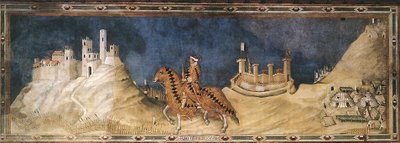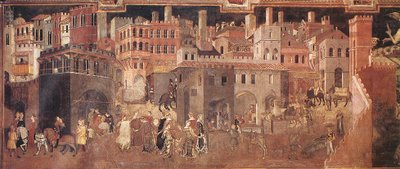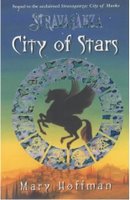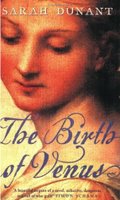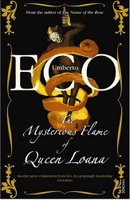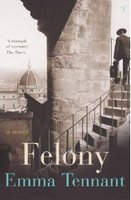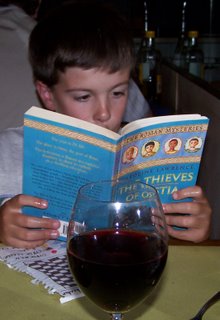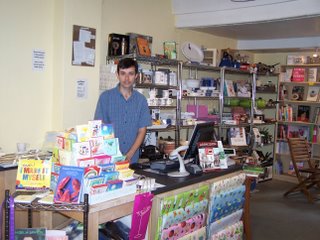
One reason for continuing with the Wenlock Grand Tour, despite Mrs Wenlock's accident (she is recovering very well, and should be out of her sling in two weeks from today), was that the third part of the journey would put us in Siena at
Palio time.
Strictly speaking, the Palio is a silk banner, as seen on the left, being paraded from the Duomo. In practice the word is used to refer to the horse race for which it is the prize. There are two races each year, on 2 July and 16 August, and Siena is packed in the days leading up to the race, despite the fact that, as an event, it makes no real concessions to non-Sienese. The Palio remains a thoroughly local event.

The race is contested in the Piazza del Campo, in the heart of the town, between horses representing ten of the city's seventeen
contrade, or districts. In the days before the race itself practice races are run, and it is not uncommon to run into the horse of one or other
contrada at the front of a passionate, chanting crowd of its
contradaioli, on the way to or from one of these races. On the right is Zodiach, wearing the colours of
Nicchio,
the Noble Contrada of the Shell. I will say more of the race in another post.
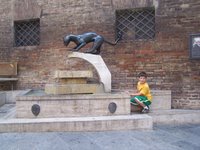
The
contrade are far more than supporters of a particular team in a horse race. They play a role in almost all the major rites of passage of every Sienese life, from a second baptism in your native
contrada's fountain (the Wenlock Heir is shown here beside the fountain of
Pantera,
the Contrada of the Leopard), through education - summer camps for the youth of the
contrada, for instance, marriage - almost invariably in the
contrada's own Church, and support, both social and financial, in old age.

The territories of the different
contrade are marked out on building walls, so that you can always tell in whose patch you are walking. In this case we are in the territory of Bruco,
the Noble Contrada of the Caterpillar. The
contrade are often given credit for the remarkably low levels of crime in Siena. However some (but by no means all) of the
contrade have historic
rivalries with each other -
Pantera and
Aquila,
the Noble Contrada of the Eagle, for instance. In the build-up to the race, these rivalries can turn into street fights among small gangs of
contrada youths. It is therefore sensible to be conscious of the risks of wearing the yellow and turquoise of
Tartuca,
the Contrada of the Turtle, when wandering the streets of
Chiocciola,
the Contrada of the Snail. Little street markers help.

But in Palio time the street markers are supplemented by the banners that fly from every building, and run down every street. The two banners on the left mark the border between
Tartuca and
Chiocciola, although we saw no signs of trouble as we walked by.
As might be expected, there is more noise and enthusiasm within the contrade who have horses running in the race than among those that do not, and the whole
North-Eastern corner of town was a quiet refuge from the crowded masses, with
Istrice,
Lupa,
Giraffa,
Leocorno and
Civetta taking no part, and of the competing
contrade only
Bruco amongst them.

It is not only the banners that brighten up Siena in Palio time. Frequently we heard the sound of drumming coming down the streets, signalling the passage of a procession of
contrada heralds heading to or from one or other of the pre-Palio ceremonies. Here the banners of
Oca,
the Noble Contrada of the Goose, and
Valdemontone,
the Contrada of the Ram.
All seventeen
contrade carry their
stemme, or banners, in these parades, and indeed on the day of the race there are even representatives of six other
contrade,
Gallo (the Chicken),
Leone (the Lion),
Orso (the Bear),
Quercia (the Oak Tree),
Spadaforte (the Broadsword) and
Vipera (the Snake) that no longer exist, following the decree of 1729 which set down the present boundaries.
The Palio is not some folkloric pageant. It has been in continuing existence since the Thirteenth Century, and while it has evolved in many ways (the current
contrada heraldry is 19th Century, as the Royal insignia of the Savoy King Umberto on many of the
stemme attests). I cannot claim to have understood much of what we saw while we were in Siena, but I found it fascinating. I am glad that we were there for it, and I look forward to going back some day, with a deeper understanding of how Siena works, to appreciate another Palio. I do know, however, that I will never be able to be properly part of it, as I am not Sienese. But that, I think, is one of the Palio's great strengths.
 One cannot visit Italy without seeing some fantastic frescoes. Young Wenlock and I spent an hour or so queuing up outside the Vatican so that we could traipse through the museums before ending up in the Sistine Chapel, but given its reputation, the ceiling was always going to be a bit of a disappointment. I did quite like the Last Judgement, but Young Wenlock was more taken by Hannibal invading Italy on the wall of the Palazzo dei Conservatori.
One cannot visit Italy without seeing some fantastic frescoes. Young Wenlock and I spent an hour or so queuing up outside the Vatican so that we could traipse through the museums before ending up in the Sistine Chapel, but given its reputation, the ceiling was always going to be a bit of a disappointment. I did quite like the Last Judgement, but Young Wenlock was more taken by Hannibal invading Italy on the wall of the Palazzo dei Conservatori. Siena has some wonderful frescoes. Simone Martini's Maesta of 1315, in the Palazzo Publico, is a great deal brighter and bluer than this picture (or the larger version that it links to) would have you believe. You might get a better idea of the colours from the Siena website, but their picture is so very blurred.
Siena has some wonderful frescoes. Simone Martini's Maesta of 1315, in the Palazzo Publico, is a great deal brighter and bluer than this picture (or the larger version that it links to) would have you believe. You might get a better idea of the colours from the Siena website, but their picture is so very blurred.